High-end diecast model cars at 1:18 scale can have over 180 parts. This intricacy showcases the quality and craftsmanship of these miniature marvels. Manufacturers are pushing precision limits to captivate enthusiasts as popularity soars.
Diecast model car quality depends on manufacturing processes and materials used. Zinc alloy is a favorite for its casting properties and durability. This material choice greatly impacts the models’ overall quality.
Production methods are crucial for diecast car quality control. Mechanical die-casting allows mass production, while handmade manufacturing offers exquisite detail. Brands like Paudi set high standards with strong design teams and advanced equipment.
Quality assessment goes beyond aesthetics in diecast model cars. Weight, parts count, and attention to details contribute to a model’s value. Understanding these quality indicators is key to building an impressive collection.
Classic Ford Mustang GT Supercars and unique Gloster Sea Gladiator aircraft are examples of collectible models. These pieces showcase the variety and appeal of diecast model collecting.
Key Takeaways
- High-end 1:18 scale models can have over 180 parts
- Zinc alloy is preferred for its casting properties and durability
- Manufacturing methods impact quality and collectibility
- Weight, parts count, and detail precision are crucial quality indicators
- Reputable brands like Paudi set high standards in the industry
- Diecast models come in various themes and scales
Understanding Diecast Model Car Manufacturing Methods and Materials
Diecast car manufacturing has fascinated collectors since the early 1900s. It blends precise engineering with artistic skill to create mini masterpieces. Let’s dive into the world of diecast car materials and production.
Die-Casting Production Process
Die-casting creates the main body of diecast model cars. This method uses zinc or lead alloys for higher quality and durability. Molten metal is injected into molds to form the car’s shape.
Handcrafted Manufacturing Techniques
High-end models rely heavily on handcrafting. Paudi Model’s 1/18 scale cars have over 200 parts. Six workers spend about six minutes on just the inner door panel. This careful approach ensures exceptional detail.
Why Zinc Alloy Dominates Diecast Production
Zinc alloy, specifically zamak, is the top choice for affordable diecast cars. It allows for complex structures and resists corrosion. This material makes diecast model cars durable and valuable.
Alternative Materials in Model Car Production
Diecast car brands use plastic and rubber for certain parts. Plastic injection creates tires, wheels, and grills. Glass pieces may be made through vacuum forming.
These varied materials allow for intricate details and realistic looks. Diverse diecast car materials create lifelike miniatures.
- Headlights and taillights use separate molds with colored injectable plastics
- Spray-painting and airbrushing enhance aesthetic appeal
- Thorough quality control ensures standards are met before packaging
The diecast car industry keeps evolving. It balances old-school craftsmanship with new techniques. This approach satisfies collectors’ desires for both budget-friendly and premium models.
How Is Quality of Diecast Model Cars: Essential Assessment Criteria
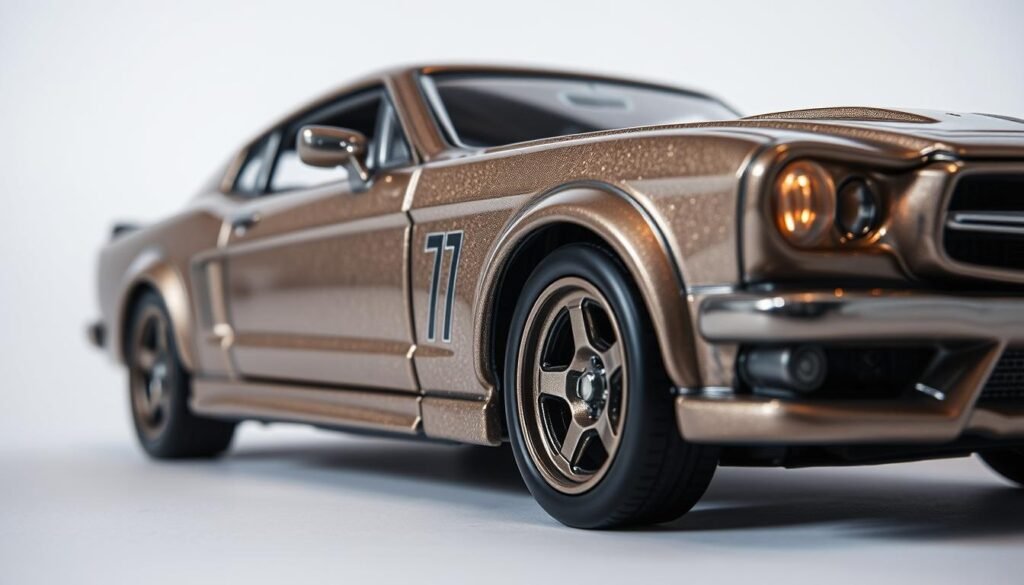
Assessing diecast car accuracy involves several key factors. These criteria help determine a model’s quality and value. They ensure collectors get the most authentic representation possible.
Weight and Material Distribution Analysis
Quality diecast models feel substantial in your hand. Heavier models often indicate fewer plastic parts. The weight distribution should mimic that of the real car.
Parts Count and Scale Accuracy
The number of parts can indicate a model’s quality. High-end 1:18 scale models typically feature over 180 parts. Scale accuracy is crucial, with common ratios including 1:18, 1:24, and 1:64.
Surface Finish and Paint Quality
Diecast car finishes greatly impact a model’s appeal. Quality models boast smooth, even paint jobs with deep luster. Zinc alloy provides an excellent base for paint application.
Detail Precision and Craftsmanship
Details are crucial in diecast car models. Look for precise reproductions of badges, grilles, and interior elements. High-quality models often feature functioning parts like opening doors and hoods.
Door Gaps and Panel Fitment
Examine how well doors, hood, and trunk align with the body. Minimal gaps and smooth panel fitment indicate superior craftsmanship. This mirrors the attention to detail found in full-size vehicles.
| Quality Indicator | High-End Model | Low-End Model |
|---|---|---|
| Parts Count | 180+ | ~100 |
| Paint Finish | Smooth, even, deep luster | May have imperfections |
| Functioning Parts | Multiple (doors, hood, trunk) | Limited or none |
| Panel Gaps | Minimal, consistent | Noticeable, irregular |
Conclusion
Diecast model cars blend artistry and engineering beautifully. They offer a wide range of quality and craftsmanship. High-end models, often limited editions, showcase exceptional detail and precision.
Premium collectibles from CMC and Exotor undergo strict quality control. Every tiny screw and logo is accurately reproduced. These models justify their higher prices with superior craftsmanship.
For beginners, 1:18 scale models are a great starting point. They offer detailed craftsmanship in a manageable size. Hot Wheels dominates the 1:64 scale, while Maisto excels in larger replicas.
Your choice between affordable and high-end models depends on your goals. Consider your collecting ambitions and budget when making decisions. Each type of model offers unique benefits to collectors.
Diecast model cars are more than just displays. They can be valuable educational tools, teaching mechanics and automotive history. The diecast world offers endless learning and enjoyment opportunities.
Keep an eye on limited editions and special releases. These rare finds can increase in value over time. This adds an exciting investment aspect to your hobby.
Understanding diecast car quality and collectibility is crucial. It helps you make informed decisions and fully enjoy this captivating pastime. Your knowledge will guide you in building an impressive collection.
FAQ
How can I assess the quality of a diecast model car?
What are the main manufacturing methods for diecast model cars?
Why is zinc alloy the dominant material in diecast model car production?
What other materials are used in model car production?
What are the common reduction scales for diecast model cars?
How does the quality of diecast model cars vary in the market?
What role does quality control play in the diecast model car industry?
Are minor flaws common in diecast model cars?
Source Links
- Which brand of diecast model cars is better? How to judge the quality of diecast model cars? – https://www.paudimodel.com/which-brand-of-diecast-model-cars-is-better/
- No title found – https://www.carmodels.com.au/blogs/news/16304-diecast-models-gift-buying-guide
- How Are Toy Cars Made: From Concept To Creation – https://www.tinytown.in/blogs/news/how-are-toy-cars-made?srsltid=AfmBOoouscH-TnLMW-y4UwVKPNiNIhSpdXybqlnHbjv0YFyorRSrylg-
- Manufacturing process of die-cast model car – https://www.paudimodel.com/manufacturing-process-of-die-cast-model-car/
- Affordable vs High-End Diecast Collectibles – What you need to know | MYDIECASTCARS – https://www.mydiecastcars.com/difference-between-affordable-vs-high-end-diecast-cars/?srsltid=AfmBOoop1T61_aWOukvQfD6KMFEuI_mhAqDk5riuvN_WwLA218u1twKo
- Assessment Methods – https://www.jcu.edu.au/centre-for-education-and-enhancement/assessment-at-jcu/assessment-methods
- NEAS QUALITY FRAMEWORK – NEAS – https://neas.org.au/resources/neas-quality-framework/
- Affordable vs High-End Diecast Collectibles – What you need to know | MYDIECASTCARS – https://www.mydiecastcars.com/difference-between-affordable-vs-high-end-diecast-cars/?srsltid=AfmBOoqs6oOi_mBtm-U-Zomc5VktztR6w3kbUmilkpsehnaKwJOKO-Xj
- Introduction to Diecast Model Cars – Five Diecast – https://fivediecast.com/introduction-to-diecast-model-cars/
- Diecast Toy Cars: Best Models, Collectibles, and Guide for All Ages – https://siritoycollections.com/diecast-toy-cars-best-models-collectibles-and-guide-for-all-ages/?srsltid=AfmBOorcKBisPFnWe_bQWnYsh4QgizvUTi0cLo6NbxLqibXUHhuF5cgk

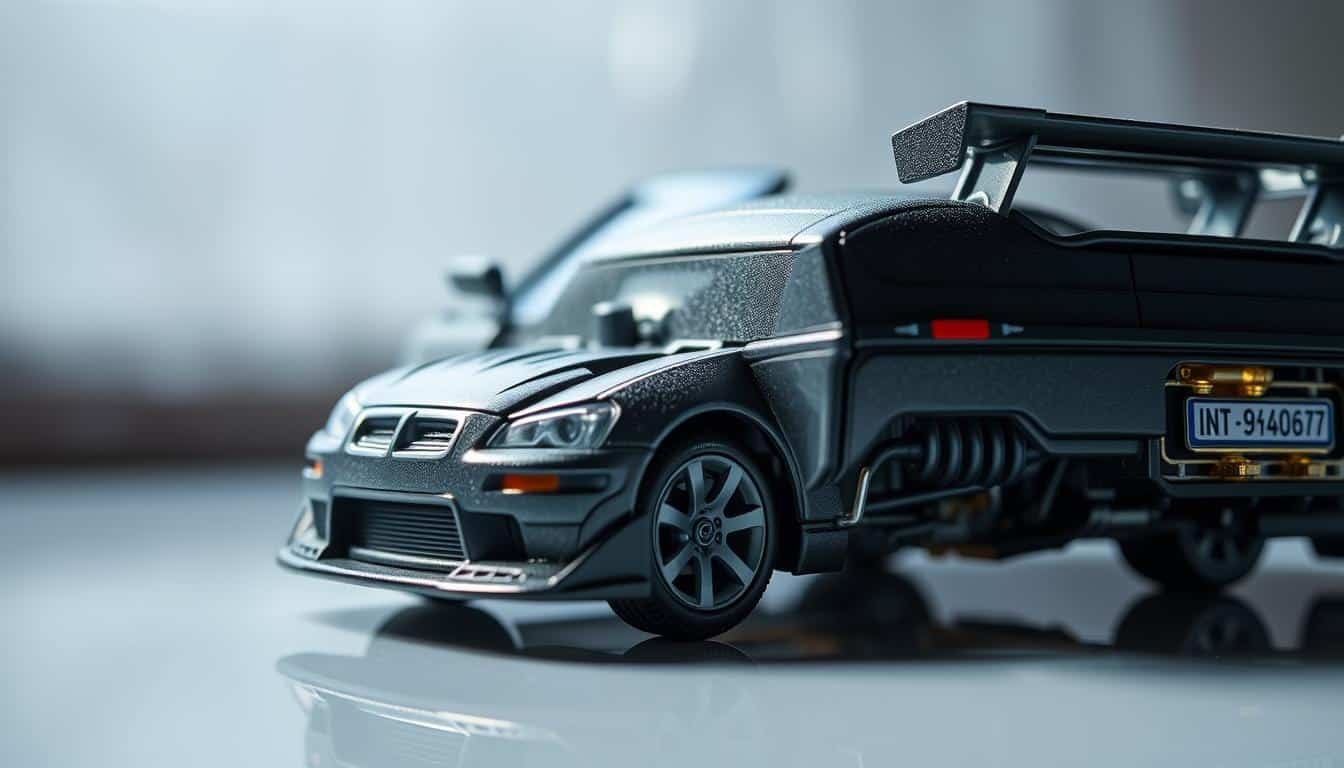
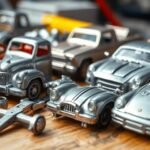
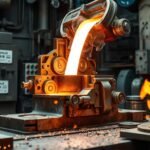

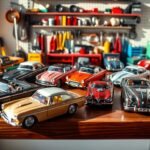


Interesting read, but shouldnt we also consider environmental impacts of different manufacturing processes for diecast model cars?
Interesting read, but dont you think handcrafted techniques have a unique charm that die-casting cant replicate? Just a thought.